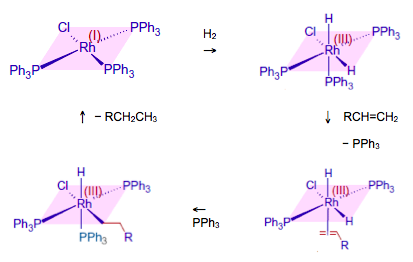Catalysts

 A.3 Catalysts (1.5 hours)
A.3 Catalysts (1.5 hours)
Pause for thought
It is fairly easy to see how a heterogeneous catalyst works. Two reacting gases, e.g. hydrogen and ethene, adsorb onto the surface of a transition metal such as nickel or palladium. This brings the two reactants close together and with the right orientation producing an alternative pathway with a lower activation energy than the uncatalysed reaction. Once the product has formed, it is then desorbed. It is less easy to find good examples of how homogeneous catalysts work. One that is often given (and I use in my Study Guide) is the reaction between peroxodisulfate(VI) ions and iodide ions, which is catalysed by iron(II) ions. It is thought that the Fe2+(aq) ions are oxidised to Fe3+(aq) ions and then back to Fe2+(aq) ions.
S2O82−(aq) + 2Fe2+(aq) → 2SO42−(aq) + 2Fe3+(aq)
2I−(aq) + 2Fe3+(aq) → 2Fe2+(aq) + I2(aq)
Although this shows that the oxidation state of the iron changes, it does not show any intermediate compound formation. One really good example to use is slightly esoteric as it involves a transition metal complex with a ligand that IB students will be unfamiliar with. This ligand is triphenylphosphine, P(C6H5)3 – shortened to PPh3. However the chemistry is easy to follow and students should recognise the phenyl functional group. The catalyst, chlorotris(triphenylphosphine)rhodium(I), is known as ‘Wilkinson’s compound’ named after Professor Sir Geoffrey Wilkinson (1921-1996) who discovered it and who went on to win the Nobel Prize in 1973 for his work on transition metal complexes. It has the formula RhCl(PPh3)3 and is a good homogeneous hydrogenation catalyst for alkenes.

Proposed mechanism for hydrogenation of an alkene catalysed by RhCl(PPh3)3
Chlorotris(triphenylphosphine)rhodium(I) is a square planar complex. The triphenylphosphine is analogous to ammonia so behaves as a neutral ligand. Students should be able to confirm that the oxidation state of rhodium in the compound is +1, as shown by its name. In solution hydrogen adds to the complex to form an octahedral complex. This is known as oxidative addition as the oxidation state of the rhodium has increased to +3. One of the triphenylphosphine ligands is now replaced by an alkene, which bonds via the pi electrons in the double bond. This brings the alkene close to the hydrogen atoms and it is thought that the rate-determining step is the addition of one of the hydrogen atoms to the alkene followed by the insertion of a triphenylphosphine molecule into the vacant site left by the hydrogen atom. The alkyl radical then reacts with the remaining hydrogen atom and leaves in a process known as reductive elimination to regenerate the original rhodium(I) compound.
Intermediates such as those shown above are obviously highly reactive so it is impossible to prove any suggested mechanism by isolating all the intermediates, although chemists have come up with several ingenious ways in which their presence can either be shown or inferred.
Nature of science
Catalysts were used to increase the rates of reactions long before it was understood how they work. Developments in the mechanism of catalysis have led to the use of models that are constantly being tested and improved.
Learning outcomesAfter studying this topic students should be able to: Understand:
Apply their knowledge to:
| Clarification notesCatalytic properties, such as selectivity for only the desired product, efficiency, ability to work in mild/severe conditions, environmental impact and impurities, should be considered. Carbon nanocatalysts and their uses should be covered. International-mindednessThe theft of catalytic converters is on the increase globally due to the value of the precious metals, rhodium, palladium and platinum, which are commonly used as the catalysts in these converters. |
Teaching tipsThis is quite a factual sub-topic with no real quantitative aspects. Essentially students need to know what a catalyst is, how heterogeneous and homogeneous catalysts differ, the two main mechanisms of catalysis, some specific catalysts to use as examples, specific details of zeolites and carbon nanocatalysts and the factors to be taken into account when choosing a suitable catalyst. It may be semantics but impress upon your students that catalysts do not lower the activation energy of a reaction. What they do is provide an alternative pathway that has a lower activation energy. Heterogeneous catalysts normally work by adsorbing reacting gases onto their surface and thereby bringing the reactants close together with the correct orientation before the products are desorbed. Metals such as palladium are particularly good at adsorbing and desorbing gases. Homogeneous catalysts work by forming intermediate compounds involving a change of oxidation state, again this brings the reactants close together and as they react they leave the catalyst which reverts to its original oxidation state. Compounds of transition elements tend to make good catalysts as the metals can relatively easily change their oxidation states. Poisons, such as sulfur and cyanide ions, need to be removed from reactants as they combine irreversibly with the catalyst thus blocking it from forming complexes with the reactants. The real strength of carbon nanoparticles is their huge surface area. They also tend to be good conductors and chemically inert, properties that can enhance their efficiency as catalysts. Zeolites, which are much used in the petroleum industry, for example in cracking, work by adsorbing reactants molecules and confining them in a small volume (cage) so that they can react together. | Study GuidePage 113 QuestionsFor ten 'quiz' questions (for quick testing of knowledge and understanding with the answers explained) MC test: Catalysts. For short-answer questions see Catalysts questions together with the worked answers on a separate page Catalysts answers. Vocabulary listadsorb / adsorption |
Teaching slides
Teachers may wish to share these slides with students for learning or for reviewing key concepts.
Other resources
1. A down to Earth description of what a catalytic converter is and how it works. It is worth putting up with the miaow to start with!
2. A short but informative video on what zeolites are and what they can be used for by Jeff Rimer of the University of Houston Cullen College of Engineering.
3. A good overview of the use of nanoparticles including their use as catalysts in fuel cells from Bytesize Science. To show how fast the technology is changing it shows an "old" inefficient fuel cell based on platinum (which is all of eleven years old!) which produces 100 W and compare it to a modern fuel cell using nanoparticle sized catalysts that produces 1 kW.
![]() Developments in nanotechnology
Developments in nanotechnology

 IB Docs (2) Team
IB Docs (2) Team 

















